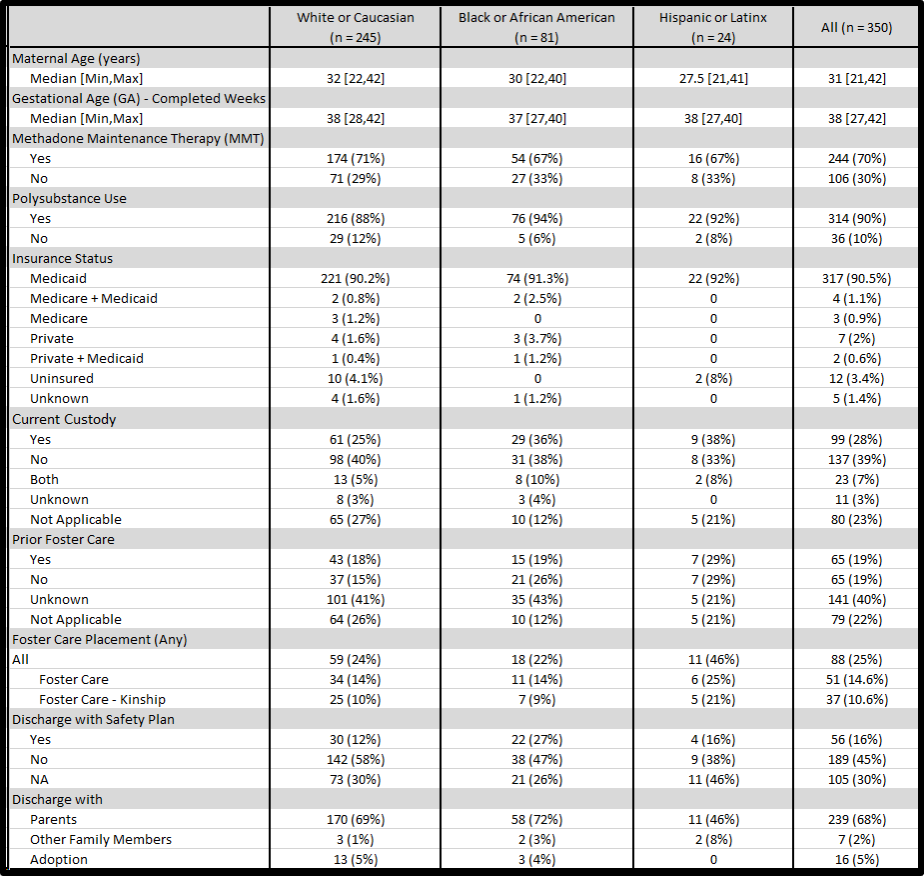Neonatal-Perinatal Health Care Delivery: Epidemiology/Health Services Research
Neonatal-Perinatal Health Care Delivery 2: Epi/HSR Equity
637 - Racial Disparities in Foster Care Placement of Opioid Exposed Infants
Publication Number: 637.141

Zubair Aghai, MD (he/him/his)
Professor of Pediatrics
Sidney Kimmel Medical College at Thomas Jefferson University
Philadelphia, Pennsylvania, United States
Christina E. Lewis, MD MSc PH (she/her/hers)
PGY-3, Pediatrics
Thomas Jefferson University | Nemours Children's Hospital, Delaware
Philadelphia, Pennsylvania, United States
Presenting Author(s)
Co-Author(s)
Background:
Neonatal Opioid Withdrawal Syndrome (NOWS) is a prevalent diagnosis. However, there remains a paucity of data on racial disparities in infant outcomes. One outcome is foster care placement. Evaluating for racial inequities in placement could have important implications for child protection systems.
Objective:
This study sought to ascertain if disparities in foster care placement of opioid-exposed infants existed based on Maternal Race/Ethnicity; in particular, between Black and White mothers.
Design/Methods:
The study population was opioid-exposed infants born between April 2017 and May 2021 and admitted to the Neonatal Intensive Care Unit (NICU). Primary exposure was Maternal Race/Ethnicity, with “White or Caucasian” serving as the reference group. Social work notes in mothers’ and infants’ medical charts were reviewed for details. The primary outcome was placement into foster care. Secondary outcomes included discharge with parents and discharging home with safety plan.
Results:
379 pregnancies occurred during the study period, with exclusion criteria (unknown maternal race, only one mother in a racial group, and unknown final placement) resulting in 350 pregnancies. Of these, 23.1% (81) identified as Black or African American, 70% (245) White or Caucasian, 6.9% (24) Hispanic or Latina. Foster care placement occurred in 25% (88) of pregnancies. Of these, 22% (18/81) of Black mothers had children placed into foster care, which was similar to that of White mothers – 24% (59/245, p=0.8). However, 46% (11/24) of Hispanic or Latina mothers had pregnancies which resulted in foster care placement (p=0.03 compared to White, p=0.04 compared to Black). The prevalence ratio (PR) of foster care placement was 0.92 (95%CI 0.58,1.47) for Black relative to White, 1.90 (95%CI 1.41,2.39) Hispanic or Latina relative to White, 2.06 (95%CI 1.47,3.74) Hispanic or Latina relative to Black. With respect to discharge with safety plans, infants of Black mothers were 2.1 times (95%CI 1.88,2.35) and infants of Hispanic or Latina mothers were 1.76 times (95%CI 0.88,2.64) more likely to go home with a safety plan than infants of White mothers.
Conclusion(s):
This study identified disparities in foster care placement between infants of Hispanic or Latina mothers and both Black and White mothers. Additionally, safety plans were more likely to be implemented for infants of both Black and Hispanic or Latina mothers. Identifying racial disparities in foster care placement is critical to addressing structural racism within child protective systems and essential in building systems that better support birth parents and their children.
